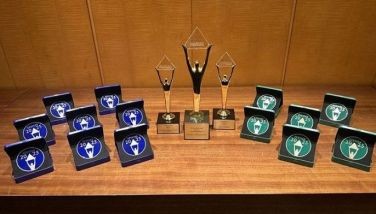In praise of Pacita Abad
Once I had a lingering encounter with a painting at the home of Ambassador Sonia Cataumber Brady. I stood before a frame of dominant shades of baffling blue, motifs of the sea accented with sparkling glass shards and bursts of colors that cheered the entire montage. The enigma of the tableau never left me. “It is a gift from the artist, my friend Pacita Abad,” Ambassador Brady told me. At the bottom of the artwork, which I eventually learned is called trapunto, is the noticeable autograph of the artist.
Over the years, that happenstance with Pacita’s art and anything about her had become a fascination. Spending days at the breathtaking Fundacion Pacita in Batanes a few years back, while marveling at the galleries and her studio, was one of the closest things I did to honor her.
As the birds happily heralded the arrival of spring here in New York, I received an email that her works will be exhibited from April to September 2024 at the MoMA PS1, a museum located at the borough where we reside. I beamed at how fortunate we are to commune with her art again. Beneath her name – PACITA ABAD – blaring in bold blue at the gallery entrance is a narrative of the exhibition. It’s a first ever retrospective of her “32-year career spanning a range of subjects from globally inspired masks and intimate portrayals of immigrant lives to patterned abstractions.”
As we celebrate our 126th year of independence, I find it timely to contemplate on Pacita’s opus and her life as a pioneering Filipina: a student leader and activist, a trailing wife, an immigrant, a patriot, a lover of life and more, who passionately and prolifically devoted more than three decades of her career in creating multi-dimensional arts of multi-faceted themes.
Pacita channeled features of her character and events of her time in art forms, brooding of her deepest affections like her love of country. One particular art she created in time for the Philippines’ centennial celebration was “100 Years of Freedom from Batanes to Jolo.” As I pored over her masterpiece – a medley of upturned triangular tapestries that draped a massive wall of the museum’s fourth floor gallery – I was once again captivated by her genius. I read from the text panel that the evocative trapunto is a mishmash of hand-woven fabrics from Baguio and Bontoc, ikat from Kalinga Apayao and tinalak scarves and malongs from Mindanao magically embellished with glittering beads and sequins.
To the keen eye and for a proud Filipino (I was that afternoon, telling fellow guests I chatted with, the artist was from the Philippines), the magnum opus draws attention to our major islands – Luzon, Visayas and Mindanao. Meshed into the montage are floral silks from Binondo and, in her own words, “my grandmother’s Spanish lace mantilla from Cebu.” Then it dawned on me how, despite our current geopolitical tension with China or undesirable historical recollections of the Spanish conquest, I feel that Pacita’s artworks still forcefully speak of our country and our people’s never ending pursuit for cooperation, harmony and understanding and how these aspirations, when peaceably discussed and realized, could make our world a better place.
I find Pacita’s paintings on social realism and the immigrant experience relatable. The oil painting, “Water of Life,” depicts a mother with her children, tilting the head of an emaciated son sipping from a bowl. It is said that while at a UNCHR camp, the empathetic artist saw “Kampuchean children rush to fill their plastic pails with water” and was touched seeing a woman “giving her son a drink from a bowl of water, while her two other sons anxiously waited for their turn.” The painting is heart-wrenching. That moment, I painfully wondered if the mother had her fill, too.
On one hand, “If My Friends Could See Me Now” portrays a woman wearing a beret against a backdrop of skyscrapers, the US flag and a cart full of groceries. It is to me a self-portrait suggestive of Pacita’s transformation while living in America. Reflective of their nomadic life (she and her husband Jack Garrity traveled and lived in over 60 countries), I think that her pieces also double as voices of her inmost longings as an observer and partaker of events in places they visited or called home.
Since Jakarta was the couple’s home for over seven years, I emailed Ambassador Brady about her memories of Pacita. She replied that upon reading a feature of her, “I realized how little I know about my friend Pacita, the artist.” She reminisces how “Gloria de Luna went with me to her house to convince her to show her work at an embassy event. I ended up with one of her trapunto paintings.”
Ambassador Brady said she would have wanted more of her paintings, “but the US embassy beat me to it for then President Bush (the father). Besides, I could not afford another ‘Pacita.’ Later she gave me another painting, this time only a head of the wayang, but more delicate. It’s now in my bedroom. I dare not display it because it is not glassed.” She recalls the couple was supposed to visit her in Myanmar, where she served as our ambassador but were “unable to get booking.” But “Pacita instead sent me a catalogue of her work to be displayed at the Jakarta National Museum.” She regretted not being able to attend her Manila exhibit, which was “a pity because it would have been nice to renew our friendship that started in Jakarta.”
In a catalogue of her work produced by the Walker Art Center, which organized the exhibit, Victoria Sung, associate curator of visual arts, wrote: “How can an artist be at once bold, emphatic, even flamboyant and yet invisible?” But Pacita is invisible no more. Her legacy of over 5,000 artworks is a fulfillment of a dying wish that her paintings would live.
- Latest
- Trending

























